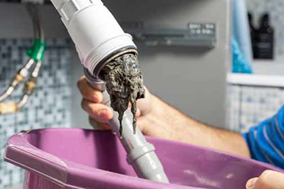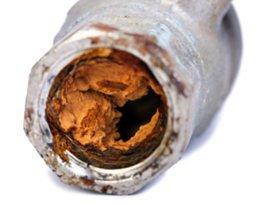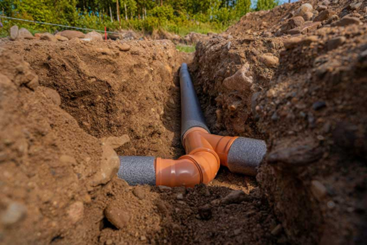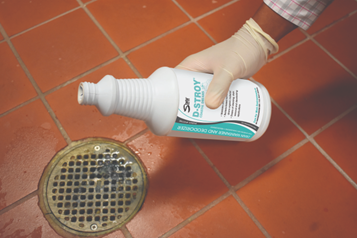Cost Comparison: Drainpipe Repair vs. Preventative Drain Maintenance
Cost Comparison: Drainpipe Repair vs. Preventative Drain Maintenance
The last expense anyone wants to deal with is a broken pipe. It means calling a plumber, getting emergency maintenance, shutting down your facility, and dealing with damages. This can be a lengthy and expensive process, and it’s more likely to happen to your facility when you don’t use preventative drain maintenance.
State Chemical has been selling lines of drain maintainers for different needs for decades. We’ve seen damaged pipes, and we’ve seen how that damage can be prevented. You may be asking, “If I have to pay for preventative maintenance on a regular basis, won’t that end up costing more than pipe repair in the long run?”
The short answer is no, but to fully answer this question, we’ve compared the cost of pipe repair and replacement to the cost of preventative maintenance. After reading, you’ll know the cost difference between the two options.
What Happens If I Don’t Take Care of My Drains?
If you don’t use preventative drain maintenance, your facility may face many different problems.
The unmaintained buildup of fats, oils, and greases (FOGs) and other organics can lead to slow drains, drain clogs, drain flies, foul odors, and pipe deterioration. Your facility can only last so long without functioning drains, and odors and drain flies are a health code violation as well as an instant turnoff to customers. All of these issues will require prompt reactive maintenance to keep your facility running, so you must act quickly if you end up in this situation.
The worst-case scenario within this realm is the possibility of broken pipes. Pipes would have to be left unmaintained for years to reach this outcome, but if you're in that situation, what would that cost you?
How Much Does It Cost to Repair Pipes?
With less severe pipe damage, repairs may be possible rather than full-on pipe replacement. Commercial plumbers typically charge around $50–$120 per hour for these repairs.
Then, you’ll need to consider the cost of repairing the pipe itself, which will often vary depending on how accessible it is. A leak on an easily accessible pipe (e.g., the pipes you can see under your sink) may cost $150–$400, depending on severity.
However, a repair on a pipe that is concealed (e.g., behind a wall) can cost $450–$750. Meanwhile, repairing a pipe under a floor or slab can cost between $600 and $4,000. The price will also vary based on how much of the pipe needs to be repaired or how many leaks you may have.
The price adds up quickly depending on your situation, and unfortunately, you cannot control where your pipe acts up. Repairs are less invasive than replacements, but they can become invasive the harder they are to access.
Let’s imagine that you own a large restaurant. You have a grease disposal container, but it’s no secret that your staff rarely uses it. One day, all the grease drainage catches up with you, and your kitchen sink won’t drain, the toilets are backing up, your entire staff is in a frenzy—you have a massive FOG clog in your main line.
To resolve this, you’ll need a plumber to drill into your main line to manually remove the clog—and quickly. This last-minute expense will be the cost of a repair on a concealed pipe at $600–$4,000. Why? Your main line is not easily accessible, and it is also more expensive to repair since it's a major pipe. On top of this, you’ll also need to factor in hours of labor, the cost of temporary closure, and repairs to your facility. In a scenario like this, you’ll have to spend at least several thousand dollars.
How Much Does It Cost to Reline Pipes?
If you require more than a mere pipe repair, relining your pipes might work rather than replacing them depending on your situation. Although the materials used will cost more, you won’t have to tear up the walls or floors to reach your concealed pipes. Therefore, it usually still costs less than total pipe replacement.
Using epoxy to reline your pipes will generally cost you $50–$250 per linear foot of piping. Let’s say you have 30 feet of piping that’s wearing down but still salvageable. To save money, time, and a headache, you decide to reline them rather than replace them. That will cost you between $1,500 and $7,500 plus the hourly cost of a plumber ($50–$120).
Let’s imagine that your plumber spends six hours on this job when everything is said and done. You’ll be looking at a total price tag of $1,900–8,220.
How Much Does It Cost to Replace Pipes?
If you must fully replace one or more pipes, this cost only increases.
The pipes themselves will usually cost $0.50–$20 per linear foot depending on what material you elect to use. Then, you’ll have to pay the plumber per hour ($50–$120), a city inspection fee ($100–$500), and a permit fee ($100–$500).
Let’s imagine that your pipes have corroded and need to be replaced. The affected area is 30 feet long, so that will cost $15–$600. Then, let’s say that it takes the plumber 20 hours to finish the replacement: that’s an extra $1,000–$2,400. With the city inspection and permit fees added in, this repair will cost you between $1,215 and $4,000.
Depending on the project, you may need more or less piping replaced, your local fees may vary, and the hours worked may differ. Plus, when you replace pipes, your facility will have to close for repairs, so you also need to factor in lost revenue and collateral damage. All this considered, it’s easy to see that pipe replacement is a large undertaking.
How Much Does Preventative Drain Maintenance Cost?
So, how does the cost of preventative drain maintenance compare?
Industrial drain maintainers are usually $0.20–$1.10 per ounce. Let’s say that you use eight ounces of your drain maintainer each week, equaling out to 32 ounces per month. That’s $6.40–$35.20 per month—or $76.80–$422.40 per year.
Repairing an easily accessible pipe may cost you less, but with the obvious risk of greater damage, preventative drain maintenance is a significant savings compared to the average cost of pipe repair and replacement.
In Sum, Preventative Drain Maintenance is Less Expensive in the Long Run Compared to Eventual Pipe Repair Costs
It’s easy to question if preventative maintenance is worth the upfront cost or if you’ll be better off paying the fee when there’s a problem. But the fact of the matter is that without preventative maintenance, your pipes will need to be repaired or replaced more quickly, and it will be more expensive than preventative maintenance would have been.
To learn more about preventative maintenance, consider the cost of a drain care agreement with State Chemical.












